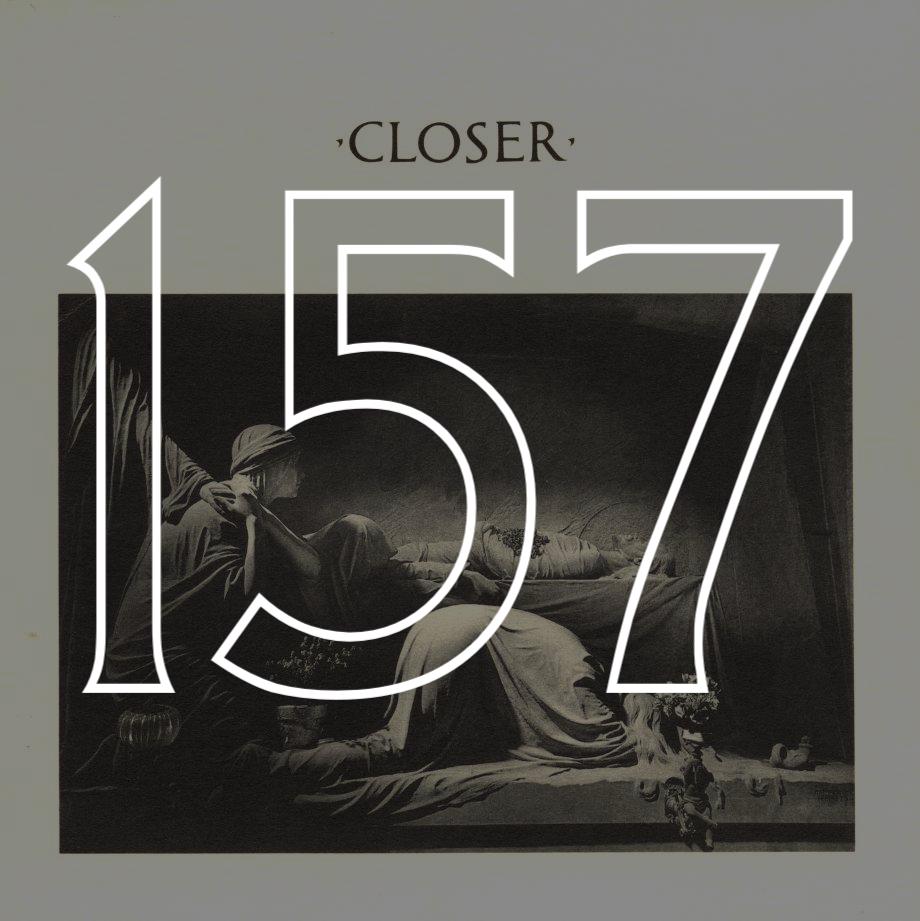#157: Joy Division, "Closer" (1980)
I can’t tell you precisely when I knew that Joy Division had stopped being “just” music for me. It might have been a spring day in 2009; I was driving home after making the decision to have a total hysterectomy. I turned the volume up on “Disorder,” as loud as it would go, and started screaming the lyrics: “I’VE GOT THE SPIRIT! BUT LOSE THE FEELING! FEELINGFEELINGFEELING FEEL-ING.” I was empty, but I had taken the music and the words into my body. It had weight, and it held me. But this was not the first time Joy Division had done this to me.
Twenty years earlier, I was fifteen years old, and in the middle of what would become a three-month stay in a state psychiatric hospital for adolescents. It wasn’t the first time that I’d been hospitalized for depression and suicidal thoughts, and it wouldn’t be the last. When Closer came into my life, I was considered stable enough to come home for overnight visits; my mother saved whatever mail came to me, usually the latest issues of Rolling Stone and Spin. That particular Rolling Stone had one of its endless lists: The Best Albums of the 80s (so far), maybe, or the Greatest Post-Punk Albums Ever. It only matters now because Closer was on that list. I read about it before I heard it. I read the lyrics of “Isolation” to my mother:
Mother I tried please believe me
I’m doing the best that I can
I’m ashamed of the things I’ve been put through
I’m ashamed of the person I am
My mother wondered if I should be listening to something like that, but she didn’t say no. I didn’t tell her that Ian Curtis, barely out of adolescence himself, had committed suicide. I went to my hometown’s only record store the next day and bought the cassette I still own. What I heard in those first moments, the opening of “Atrocity Exhibition,” seemed like the noise of a machine grinding against metal, or grinding against bone, and then, a voice, one minute barely floating above that, and then dipping down into it, relentless, chanting: this is the way. Here was music that knew shame, and guilt, and pain. Here was music that would protect me. I took the tape back to the hospital at the end of the weekend. When I was admitted, I was told it was for my safety. I would learn how to function again, and live without wanting to die. The locked door of the unit, the security screens on the windows, that could only open with a key: these precautions kept me away from the world, but they did little to keep me safe. I was sexually abused there, and in the aftermath of that I shut down. I stopped eating to the point where the staff would tell me that if I didn’t eat soon, they would force me. I learned how to tell people what they wanted to hear if it would let me leave sooner. I buried the event itself in some remote corner of my body, denying that it happened, but watching its slow poison do its work over the years.
I held Closer to me for a long time. I grew up, but didn’t hold onto it out of some wistful longing to go back to the time when I first heard it. As I got older, I found other people who thought it was speaking directly to them; a perfect articulation of being trapped and depressed and desperate. In such a state, making art becomes a necessity: write it out, or make music; smear paint on a canvas so that no light shines through; if Closer has taught me anything, it has taught me to hold on, however much I might think that dying or slow self-destruction are viable answers. This is not to say that I see it as “therapeutic.” It isn’t. The critic in me sees it as a perfect vehicle for the talents that made it. The other part of me, the woman who carries the past and attempts to wrestle with it, sees it as a partially successful exorcism: whatever is still trapped in me finds its voice in that album. I run my fingers over the pages of So This is Permanence, a collection of Joy Division lyrics and Ian Curtis’s notebooks, and I murmur the words to myself, an incantation to keep a faulty radio signal from whispering its darkest impulses to me.
Last year, I saw New Order live for the third time. Their encores are now devoted to Joy Division material, and a backdrop which says “FOREVER JOY DIVISION” comes up. It seems off, somehow; a gimmick when compared to Peter Hook and his band, the Light, which dives into the music from both New Order’s and Joy Division’s catalogs with an exhilarating ferocity. Last April, with New Order, “Decades” was the song to end the night. On a giant screen, Ian Curtis danced and hovered above the audience, breaking off into smaller pieces with each movement, a restless, fragmented ghost. Bernard Sumner’s voice is higher and lighter than Curtis’s was. I closed my eyes, and swayed; the music holding me again, a longing, a protection.
—Sarah Nichols

